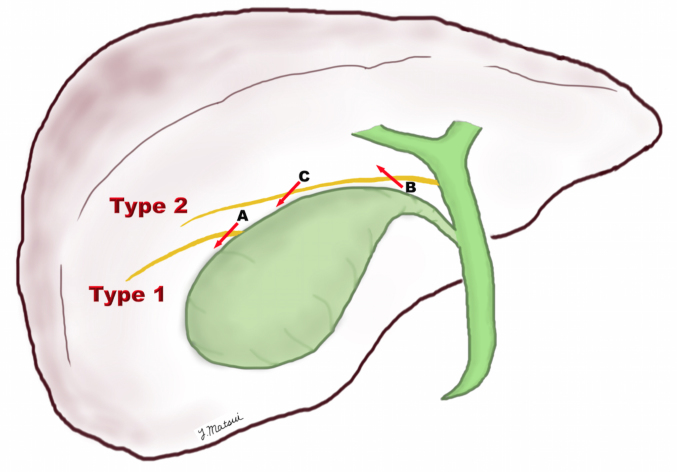Aberrant biliary ducts in the gallbladder bed are called ducts of Luschka. The ducts are a significant source of bile leakage after cholecystectomy.1–5 We have encountered two different types of these ducts: one draining directly into the gallbladder (type 1), and the other running along the gallbladder bed and draining into the hepatic duct (type 2) (Fig 1). Using videos (available online as supplementary material), we demonstrate the procedures employed to manage injuries of these ducts.
Figure 1.
The two types of ducts of Luschka: one draining directly into the gallbladder (type 1), and the other running close to the gallbladder and draining into the hepatic duct (type 2). The red arrows indicate where the ducts of Luschka were injured during cholecystectomy
Video 1 shows an injury to a type 1 duct of Luschka. The duct was injured at its point of connection to the gallbladder (marked ‘A’ in Fig 1). After removal of the gallbladder, a slight outflow of bile from a slender filament on the gallbladder bed was noted. The filament was clipped and the bile leak stopped.
Video 2 shows the first of two injuries to a type 2 duct of Luschka. The duct was injured at its central part, near the hepatic duct (marked ‘B’ in Fig 1).
Video 3 shows a second injury to a type 2 duct. The duct was injured at its peripheral part (marked ‘C’ in Fig 1). After removal of the gallbladder, bile leakage was observed from a specific region on the gallbladder bed. Sutures were placed to close the duct stump and the bile leak ceased. There were no postoperative complications.
If bile is noted and an injury to the duct of Luschka is observed, the injured duct should be closed with a clip or suture to prevent postoperative bile leakage. Knowledge of these rare injuries to ducts of Luschka would be helpful for surgeons.
References
- 1.McQuillan T, Manolas SG, Hayman JA, Kune GA. Surgical significance of the bile duct of Luschka. Br J Surg 1989; : 696–698. [DOI] [PubMed] [Google Scholar]
- 2.Kimura T, Suzuki K, Umehara Y et al. Features and management of bile leaks after laparoscopic cholecystectomy. J Hepatobiliary Pancreat Surg 2005; : 61–64. [DOI] [PubMed] [Google Scholar]
- 3.Spanos CP, Syrakos T. Bile leaks from the duct of Luschka (subvesical duct): a review. Langenbecks Arch Surg 2006; : 441–447. [DOI] [PubMed] [Google Scholar]
- 4.Schnelldorfer T, Sarr MG, Adams DB. What is the duct of Luschka? – A systematic review. J Gastrointest Surg 2012; : 656–662. [DOI] [PubMed] [Google Scholar]
- 5.Iida H, Matsui Y, Kaibori M et al. Single-center experience with subvesical bile ducts (ducts of Luschka). Am Surg 2017; : 43–45. [PubMed] [Google Scholar]



